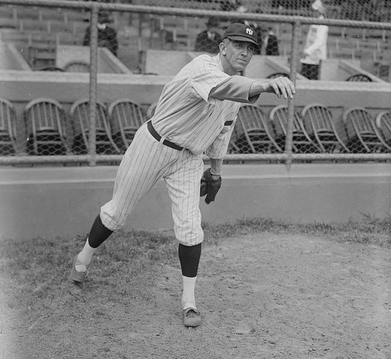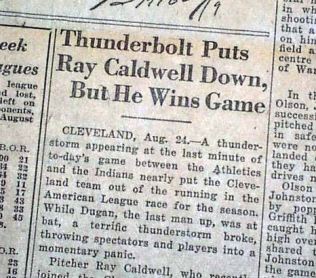 Dark, ominous storm clouds rolled off Lake Erie and barreled toward League Park. Black sky
Dark, ominous storm clouds rolled off Lake Erie and barreled toward League Park. Black sky
loomed over the ballyard, and rain, which had been falling lightly since the fourth inning,
threatened to become heavier.
The baseball game stirring underneath the clouds on this Sunday afternoon in downtown
Cleveland was nearly complete. The Indians led the visiting Philadelphia Athletics 2-1 in the top
of the ninth inning.
Ray Caldwell stood on the mound on this warm August day, pitching in his first game with the
Indians. The right hander retired the first two A’s batters as the storm above intensified.
Caldwell readied to pitch to the next to Athletics’ shortstop Joe Dugan when…
Boom!
A fearsome lightning bolt zipped from the overhanging clouds. Frightened spectators scurried for
cover.
“The bolts flashed here and there, causing much excitement,” Harry P. Edwards wrote in the
Sporting News days later. “There was a blinding flash that seemed to set the diamond on fire and
Caldwell was knocked flat from the shock of it.”
His teammates rushed in to check on the hurler, who, “lay stretched out in the pitcher’s box.”
Caldwell was down but not out. He did a quick inventory of his arms and legs. What a relief.
Everything was still attached.
The pitcher dusted off his pinstriped uniform, and readied to finish off Dugan and the A’s.
After the game, Caldwell told the Cleveland Press that the lightning strike “felt just like
somebody came up with a board and hit me on top of the head and knocked me down.”
***
Trailing the Chicago White Sox by eight games, Indians’ player-manager Tris Speaker refused
“to admit they were out of the pennant race.” The day before this matinee with last-place
Philadelphia, the Tribe had rolled off five wins in their last six games.
“They are fighting hard for every game and have been fairly successful despite the decidedly
erratic pitching the team has had,” The Sporting News claimed.
To boost the rotation, Cleveland picked up Caldwell, a fun-loving spitballer, whom the Red Sox
had released in early July.
Now weeks after the signing, Caldwell, on a day in which the Cleveland Plain Dealer had
forecasted “showers and cooler” temperatures, was pitching a masterful game in the debut for his
new team.
The Indians picked up their only two runs in the bottom of the fourth on a walk, a sacrifice, a
couple of ground outs and a throwing error by Dugan – but no hits.
The A’s scored a run in the fifth when George Burns crossed the plate on a Cy Perkins grounder.
Burns had reached base after being hit by a pitch.
Caldwell cruised through eight innings against the A’s, who had lost 13 of 14 games.
Into the ninth they went. The Athletics’ first two batters failed to reach base safely.
Then came the ruckus.
***
As Dugan stood at the plate, “Thousands of spectators were thrown into a momentary panic by
the bolt which came without warning and made as much noise as the back firing of a thousand
autos or the explosion of a dozen shells from a battery of big berthas,” the Cleveland Plain
Dealer reported the following day.
Caldwell’s teammates feared “he may have been killed,” Edwards wrote in the Sporting News,
“but he struggled to his feet, and after frisking himself to see if he was all there, pitched what
was left of the game, which was finished before the rain became a downpour.”
The lightning, the Cleveland Press reported, had knocked off Indians’ catcher Steve O’Neill’s
mask and hat, as well as Harry Davis’ navy blue A’s cap. Davis was coaching third base for
Philadelphia.
“We all could feel the tingle of the electric shock running through our systems, particularly in
our legs,” umpire Billy Evans said after the game.
Davis, the Press reported, “got a second shock, for Cy Perkins came up to feel Harry’s head and
see if he was hurt. The lightning had charged Davis’ hair with electricity and his whole frame
tingled when Cy touched him.”
Teammates also claimed to have felt an “electrical current” from lightning hitting the metal
spikes on their shoes.
“One of the players touched Caldwell on the head and leaped into the air. He said the pitcher
seemed to be crackling with electricity,” a reporter wrote in a wire story.
Is this possible?
“When lightning strikes the ground, the current flows across the surface creating a step voltage.
Someone standing with their feet apart can have current go up one leg and down the other,” said
Joseph Dwyer, a lightning researcher and professor of physics at the University of New
Hampshire. “I would think such a large current through the legs could explain the numbness
afterwards.”
One Cleveland player who complained of numbness was Ray Chapman, who nearly a year later
was killed after being hit by a pitch thrown from Yankees’ hurler Carl Mays. Running to
Caldwell, Chapman nearly fell from the numb feeling in his leg.
The lightning event was quiet frightful for the spectators.
Newspaper reports say lighting danced along the ballpark rails near where some fans were sitting
and jumped toward the pitcher’s mound.
“Lightning certainly can travel along metal railing,” Dwyer said, a phenomenon he called side
flashes.
“When lightning strikes, there is often tens of thousands of amps of current and very large
voltages,” the professor said. “If some of this current goes into a metal conductor such as fences
or railings, the current can travel long distances, causing sparks to other objects along the way.”
Even pitchers.
***
There still was one more out to go.
Still shocked, figuratively and possibly literally, from the turn of events, players took their
positions. Caldwell pitched to Dugan and “forced him to hit a grounder to Gardner just as the
clouds broke and the rain came down heavily,” wrote the Plain Dealer.
Game over. Indians 2, Athletics 1.
Caldwell pitched a complete game and allowed Philadelphia only one run and four hits. He
struck out three and walked two.
Afterward, Caldwell assessed the damage and found he had slight burns on his chest. Speculation
at the time concluded lightning had hit the metal button on his cap, “surged through his body,
and exited through his metal spikes.”
This, like a direct strike on a person, is unlikely, said Dr. Mary Ann Cooper, founding director of
the African Centres for Lightning and Electromagnetics and professor emerita at the University
of Illinois at Chicago.
“Lightning only goes through the body for perhaps three-to- four microseconds before it flashes
over the outside, and that’s not long enough to cause internal burns,” Dr. Cooper said. “It would
be nice to know what the chest burns looked like. Was there a linear burn down the middle or
sides of the chest where there would be sweat lines that lightning turned into steam causing
burns? Was it where metal was? Did he have a necklace with a cross on it, so that there was a
cross shape burned in?”
Dr. Cooper also wondered if the burns could have been fern-like, or Lichtenberg figures.
***
Caldwell recovered and Cleveland’s win meant the Indians kept pace and remained eight games
behind the American League-leading Chicago White Sox, who had also won that day, 4-1, over
the New York Yankees.
The Indians put together a run through the season’s remaining weeks, including a mid-September
streak of 12 wins in 13 games that began with Caldwell pitching a 3-0 no-hitter against the
Yankees, one of his former teams. However, Cleveland finished three and a half games behind
the White Sox, who went on to infamously represent the American League in the 1919 World
Series.
Caldwell’s electrifying performance helped spark the Indians’ late-season run. In six games with
his new club, the big righty pitched to a 5-1 record with a 1.71 ERA, proving the Indians had
made the right move in giving the pitcher, who was 31 years old at the time, another chance to
prove himself.
“When Speaker announced he was going to give Ray Caldwell a trial in the box, lots of persons
thought he was crazy,” wrote the Sporting News on Sept. 4, 1919. “But Speaker now has the last
laugh on the doubters, for Caldwell turned in and beat the Athletics easily and then all but beat
the White Sox, finally being trounced by them in the ninth inning, 3 to 2, not bad pitching for a
pitcher thought to be through as a big leaguer.”

 Remember the one about Cleveland Indians pitcher Ray Caldwell getting struck by lightning?
Remember the one about Cleveland Indians pitcher Ray Caldwell getting struck by lightning?